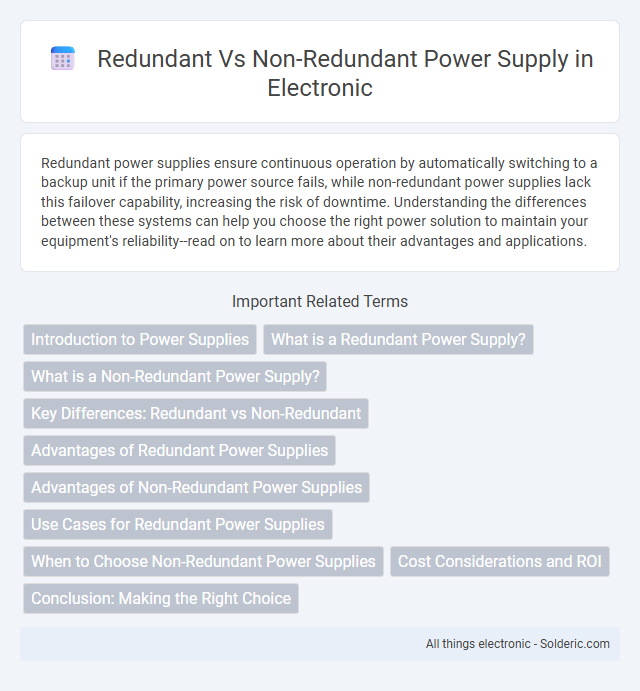Redundant power supplies ensure continuous operation by automatically switching to a backup unit if the primary power source fails, while non-redundant power supplies lack this failover capability, increasing the risk of downtime. Understanding the differences between these systems can help you choose the right power solution to maintain your equipment's reliability--read on to learn more about their advantages and applications.
Comparison Table
| Feature | Redundant Power Supply | Non-Redundant Power Supply |
|---|---|---|
| Definition | Multiple power units providing backup to ensure continuous operation. | Single power unit supplying power without backup. |
| Reliability | High reliability; system remains operational if one unit fails. | Lower reliability; failure leads to system downtime. |
| Cost | Higher initial and maintenance cost due to extra units. | Lower cost with only one power unit. |
| Use Case | Critical systems requiring zero downtime (e.g., servers, data centers). | Less critical applications where occasional downtime is acceptable. |
| Power Efficiency | May have reduced efficiency due to multiple active units or load balancing. | Typically more efficient during normal operation. |
| Complexity | More complex installation and management. | Simpler setup and maintenance. |
Introduction to Power Supplies
Power supplies are critical components that convert electrical power to the necessary voltage and current for electronic devices. Redundant power supplies provide backup by automatically switching to an alternate source during failure, ensuring continuous operation. Non-redundant power supplies rely on a single power source, which may risk downtime in case of power supply failure, impacting your system's reliability.
What is a Redundant Power Supply?
A redundant power supply is a backup electrical system designed to provide continuous power to critical devices by automatically taking over if the primary power source fails. This configuration enhances system reliability and minimizes downtime, making it essential for data centers, servers, and network equipment. You benefit from increased operational stability and protection against power interruptions with a redundant power supply.
What is a Non-Redundant Power Supply?
A non-redundant power supply is a single power source designed to provide electricity to a device or system without backup capability. If the power supply fails, the connected equipment experiences immediate downtime, posing a risk for critical operations. You should consider non-redundant power supplies for non-critical applications where continuous uptime is not essential.
Key Differences: Redundant vs Non-Redundant
Redundant power supplies provide continuous power by automatically switching to a backup unit in case the primary supply fails, ensuring high system availability and minimizing downtime. Non-redundant power supplies rely on a single power source, making systems vulnerable to power failures and increased risk of operational interruptions. The key difference lies in reliability and fault tolerance, with redundant systems designed for mission-critical environments, while non-redundant setups are typically used in less critical applications where cost efficiency is prioritized.
Advantages of Redundant Power Supplies
Redundant power supplies ensure continuous operation by providing backup power in case the main supply fails, significantly enhancing system reliability and uptime. These power supplies reduce the risk of hardware damage and data loss during unexpected power interruptions, making them essential for mission-critical applications. Your infrastructure benefits from increased fault tolerance and maintenance flexibility without shutdowns, ensuring smooth and uninterrupted performance.
Advantages of Non-Redundant Power Supplies
Non-redundant power supplies offer simplicity and cost-effectiveness, making them ideal for small-scale or budget-conscious systems where power reliability is less critical. Their straightforward design reduces maintenance complexity and minimizes initial investment, which is beneficial for deployments with predictable power needs. You can optimize your setup by choosing non-redundant supplies when continuous uptime is not a primary concern.
Use Cases for Redundant Power Supplies
Redundant power supplies are essential in mission-critical environments such as data centers, healthcare facilities, and financial institutions where continuous uptime is paramount. They ensure that Your systems remain operational during power supply failures by automatically switching to an alternate power source, thus preventing costly downtime and data loss. Non-redundant power supplies are more suitable for less critical applications where brief power interruptions are acceptable, such as basic office equipment or non-essential servers.
When to Choose Non-Redundant Power Supplies
Non-redundant power supplies are ideal for cost-sensitive applications where uninterrupted power is not critical, such as in small-scale or non-mission-critical systems. They offer simplicity and lower initial investment by relying on a single power source without backup components. Choosing non-redundant power supplies is appropriate when system downtime has minimal impact on operations or when budget constraints outweigh the need for enhanced reliability.
Cost Considerations and ROI
Redundant power supplies increase upfront costs due to the need for additional hardware and maintenance, but they significantly enhance system reliability and uptime, reducing costly downtime and potential data loss. Non-redundant power supplies have lower initial expenses but pose higher risks of operational disruptions, which can lead to more significant long-term financial impacts. Evaluating ROI requires balancing the immediate savings against the potential cost of failures, making redundant power supplies a cost-effective investment for critical systems demanding high availability.
Conclusion: Making the Right Choice
Choosing between redundant and non-redundant power supplies depends on the criticality of system uptime and budget constraints. Redundant power supplies offer increased reliability by providing backup in case of failure, essential for mission-critical applications and data centers. Non-redundant power supplies may suffice for less critical systems where cost savings outweigh the risks of potential downtime.
Redundant vs Non-Redundant Power Supply Infographic

 solderic.com
solderic.com